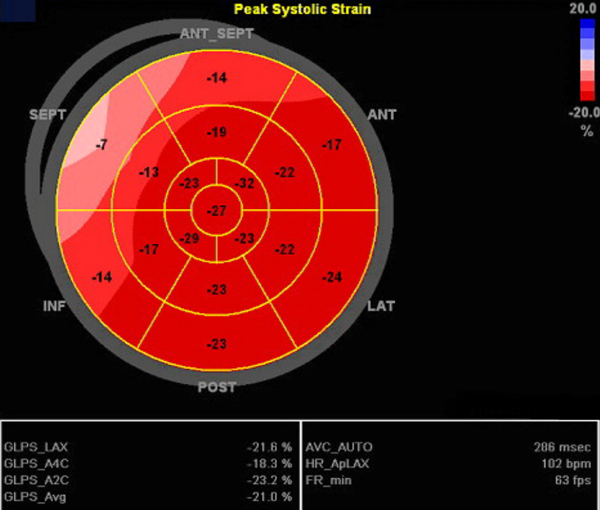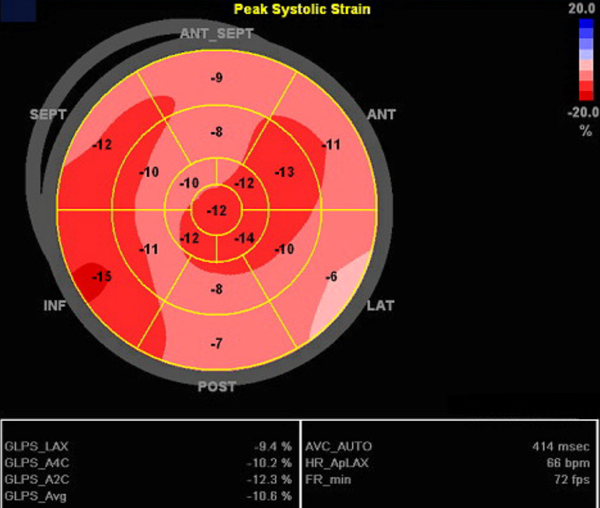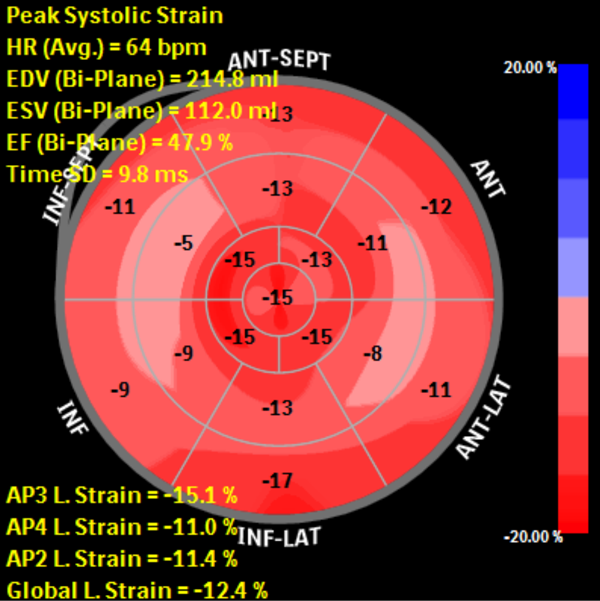The Role of Strain Imaging in Oncology and Vendor-to-Vendor Variability
Several chemotherapy agents, but in particular adriamycin, are known to cause cardiomyopathy.1,2 Ever since the first reports of possible cardiotoxic effects from anti-cancer agents, there has been well-documented, steady progress in efforts to detect and characterize this kind of pathology in clinical practice.
Once cardiac imaging was established in the late 70s and early 80s, a number of publications supported the different available modalities,3-7 establishing left ventricular ejection fraction (LVEF) as the traditional method for initial and follow-up evaluation of ventricular function during the administration of cardiotoxic chemotherapeutic agents.
Over a short period of time, measurement of LVEF by nuclear methods (multigated acquisition [MUGA]) became an established practice and was considered the gold standard for left ventricular function assessment during chemotherapy. LVEF by radionuclide imaging proved to be sensitive, specific, and reproducible and, in at least one early report when used with stress, was a predictor of early cardiac toxicity.3 LVEF, reported as a single measure, was clearly the real strength of this imaging technique.
Improvement in imaging quality, particularly in the last two decades, has been noticeable in two-dimensional echocardiography. The use of second harmonic imaging,8 as well as the use of echocardiographic contrast,9 has significantly increased the accuracy of LVEF measurement with two-dimensional echocardiography. Newer ultrasound systems are now able to achieve superior temporal and spatial resolution.
Over time, three-dimensional echocardiography has been recognized as another method for LVEF measurement that compares favorably with the considered gold standard: cardiac magnetic resonance imaging10 and conventional MUGA scan.11 But measurement of LVEF as a sole indicator of cardiotoxicity has many limitations. These include image quality or the technicality of the measurement (single beat, operator experience, and volume drawing style). In addition, the ejection fraction is merely the relative volume ejected in systole, and it can be load dependent. In many conditions affecting the heart, such as diabetes, coronary artery disease, amyloid, and hypertension, the LVEF measure may be well-preserved until late in the course of the disease. In the case of chemotherapy-related cardiac dysfunction, it has become increasingly clear that LVEF is an imperfect tool; it documents only that a process has indeed already changed, perhaps permanently12 and too late,13 the function of the myocardial tissue.
New methods for reliable noninvasive evaluation of cardiac function, such as speckle tracking echocardiography, are now available. Speckle tracking takes full advantage of a new capacity for image acquisition at higher frame rates. This new avenue for evaluation of myocardial function has helped immensely in the understanding and evaluation of some of the disorders already mentioned.14
Several reports have now been published in the cancer population receiving cardiotoxic agents, and the use of this particular technology in the realm of cancer therapeutics-related cardiac dysfunction has been very exciting, particularly the use of longitudinal deformation measures and the global longitudinal strain (GLS) value.
It was first reported in 2009 that changes in tissue deformation, assessed by myocardial strain and strain rate, were able to identify left ventricular dysfunction earlier than LVEF in women undergoing treatment with trastuzumab for breast cancer.15 Following this, two reports in 2011 have resulted in comparable findings.16,17
A multicenter collaboration17 found the cooperative use of troponin and longitudinal strain measures to predict the development of cardiotoxicity, defined as a reduction of LVEF of ≥5 to <55% with symptoms of heart failure or an asymptomatic reduction of the LVEF of ≥10 to <55% in patients treated with anthracyclines and trastuzumab. In this study, patients who demonstrated decreases in longitudinal strain measures or elevations in hypersensitive troponin had a ninefold increase in risk for cardiotoxicity at 6 months compared with those with no changes in either of these markers. Furthermore, LVEF alone, diastolic function parameters, and N-terminal pro-B-type natriuretic peptide did not help predict cardiotoxicity.
In a review including over 30 studies, it has been reported that although the best GLS value to predict cardiotoxicity was not clear, an early relative change between 10 and 15% appears to have the best specificity.18 This preceded a consensus statement19 on the evaluation of adult patients during and after cancer therapy that was published by the American Society of Echocardiography and the European Association of Cardiovascular Imaging. This document conservatively indicates, based on the currently available literature, that a relative percentage reduction in GLS of >15% is very likely to be abnormal, whereas a change of <8% appears to be of no clinical significance. It also suggests that an abnormal GLS value should be confirmed by a repeat study. The repeat study is recommended to be performed 2-3 weeks after the initial abnormal study. It should be noted that these suggestions have been reported mostly in the breast cancer population. It remains to be seen if this same cardiac imaging benefit will extend to other malignancies in their course of treatment.
In practice, however, due to the seemingly low values for relative GLS percentage change in the early follow-up of these patients, and particularly in laboratories where there are systems from multiple vendors, the concern for reproducibility and consistency among vendors continues to be a problem (Figures 1A-2B).
Figure 1A: Patient 1, Day 1, Sonographer 1, Vendor A
Figure 1B: Patient 1, Day 1, Sonographer 1, Vendor B
Figure 2A: Patient 2, Day 1, Sonographer 1, Vendor A
Figure 2B: Patient 2, Day 1, Sonographer 1, Vendor B
A joint standardization task force between professional societies and industry was initiated in 201020,21 to reduce inter-vendor variability of strain measures, and the task force's efforts have produced some initial results.22 A possible solution to this dilemma could be in the form of vendor-independent software. These would analyze images from a Digital Imaging and Communications in Medicine standard format, but the loss of the benefit from the higher frame rates of the original image data might create a disadvantage in serial follow-up of the same patient. Certainly, more research studies with solid results from such an approach are needed. For the time being, it seems only prudent at this time to recommend follow-up with the same vendor system.
References
- Kobayashi T, Nakayama R, Takatani O, Kimura K. Positive chronotropic and inotropic actions of new antitumor agent adriamycin and its cardiotoxicity--its special references to myocardial contractile force and the change of the transmembrane action potential. Jpn Circ J 1972;36:259-65.
- Lefrak EA, Pitha J, Rosenheim S, Gottlieb JA. A clinicopathologic analysis of adriamycin cardiotoxicity. Cancer 1973;32:302-14.
- Alcan KE, Robeson W, Graham MC, Palestro C, Oliver FH, Benua RS. Early detection of anthracycline-induced cardiotoxicity by stress radionuclide cineangiography in conjunction with Fourier amplitude and phase analysis. Clin Nucl Med 1985;10:160-6.
- Lenzhofer R, Dudczak R, Gumhold G, Graninger W, Moser K, Spitzy KH. Noninvasive methods for the early detection of doxorubicin-induced cardiomyopathy. J Cancer Res Clin Oncol 1983;106:136-42.
- McKillop JH, Bristow MR, Goris ML, Billingham ME, Bockemuehl K. Sensitivity and specificity of radionuclide ejection fractions in doxorubicin cardiotoxicity. Am Heart J 1983;106:1048-56.
- Pauwels EK, Horning SJ, Goris ML. Sequential equilibrium gated radionuclide angiocardiography for the detection of doxorubicin cardiotoxicity. Radiother Oncol 1983;1:83-7.
- Ramos A, Meyer RA, Korfhagen J, Wong KY, Kaplan S. Echocardiographic evaluation of adriamycin cardiotoxicity in children. Cancer Treat Rep 1976;60:1281-4.
- Senior R, Soman P, Khattar RS, Lahiri A. Improved endocardial visualization with second harmonic imaging compared with fundamental two-dimensional echocardiographic imaging. Am Heart J 1999;138:163-8.
- Hundley WG, Kizilbash AM, Afridi I, Franco F, Peshock RM, Grayburn PA. Administration of an intravenous perfluorocarbon contrast agent improves echocardiographic determination of left ventricular volumes and ejection fraction: comparison with cine magnetic resonance imaging. J Am Coll Cardiol 1998;32:1426-32.
- Chuang ML, Hibberd MG, Salton CJ, et al. Importance of imaging method over imaging modality in noninvasive determination of left ventricular volumes and ejection fraction: assessment by two- and three-dimensional echocardiography and magnetic resonance imaging. J Am Coll Cardiol 2000;35:477-84.
- Walker J, Bhullar N, Fallah-Rad N, et al. Role of three-dimensional echocardiography in breast cancer: comparison with two-dimensional echocardiography, multiple-gated acquisition scans, and cardiac magnetic resonance imaging. J Clin Oncol 2010;28:3429-36.
- Telli ML, Hunt SA, Carlson RW, Guardino AE. Trastuzumab-related cardiotoxicity: calling into question the concept of reversibility. J Clin Oncol 2007;25:3525-33.
- Cardinale D, Colombo A, Lamantia G, et al. Anthracycline-induced cardiomyopathy: clinical relevance and response to pharmacologic therapy. J Am Coll Cardiol 2010;55:213-20.
- Ernande L, Bergerot C, Rietzschel ER, et al. Diastolic dysfunction in patients with type 2 diabetes mellitus: is it really the first marker of diabetic cardiomyopathy? J Am Soc Echocardiogr 2011;24:1268-1275.e1.
- Hare JL, Brown JK, Leano R, Jenkins C, Woodward N, Marwick TH. Use of myocardial deformation imaging to detect preclinical myocardial dysfunction before conventional measures in patients undergoing breast cancer treatment with trastuzumab. Am Heart J 2009;158:294-301.
- Fallah-Rad N, Walker JR, Wassef A, et al. The utility of cardiac biomarkers, tissue velocity and strain imaging, and cardiac magnetic resonance imaging in predicting early left ventricular dysfunction in patients with human epidermal growth factor receptor II-positive breast cancer treated with adjuvant trastuzumab therapy. J Am Coll Cardiol 2011;57:2263-70.
- Sawaya H, Sebag IA, Plana JC, et al. Early detection and prediction of cardiotoxicity in chemotherapy-treated patients. Am J Cardiol 2011;107:1375-80.
- Thavendiranathan P, Poulin F, Lim KD, Plana JC, Woo A, Marwick TH. Use of myocardial strain imaging by echocardiography for the early detection of cardiotoxicity in patients during and after cancer chemotherapy: a systematic review. J Am Coll Cardiol 2014;63:2751-68.
- Plana JC, Galderisi M, Barac A, et al. Expert consensus for multimodality imaging evaluation of adult patients during and after cancer therapy: a report from the American Society of Echocardiography and the European Association of Cardiovascular Imaging. J Am Soc Echocardiogr 2014;27:911-39.
- Kaul S, Miller JG, Grayburn PA, et al. A suggested roadmap for cardiovascular ultrasound research for the future. J Am Soc Echocardiogr 2011;24:455-64.
- Thomas JD, Badano LP. EACVI-ASE-industry initiative to standardize deformation imaging: a brief update from the co-chairs. Eur Heart J Cardiovasc Imaging 2013;14:1039-40.
- Yang H, Marwick TH, Fukuda N, et al. Improvement in Strain Concordance between Two Major Vendors after the Strain Standardization Initiative. J Am Soc Echocardiogr 2015;28:642-8.e7.
Keywords: Anthracyclines, Cardiac Imaging Techniques, Cardiomyopathies, Cardiotoxicity, Cardiotoxins, Coronary Artery Disease, Diabetes Mellitus, Doxorubicin, Echocardiography, Echocardiography, Three-Dimensional, Heart Failure, Hypertension, Magnetic Resonance Imaging, Natriuretic Peptide, Brain, Peptide Fragments, Radioisotopes, Stroke Volume, Systole, Troponin, Ventricular Dysfunction, Left, Ventricular Function, Left
< Back to Listings




